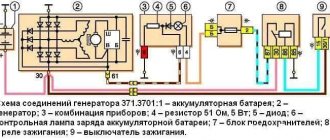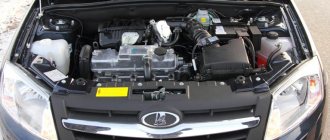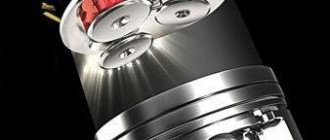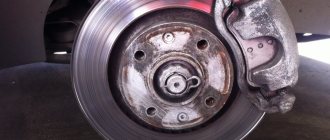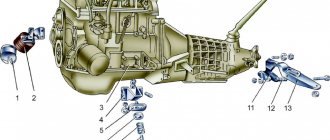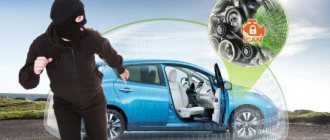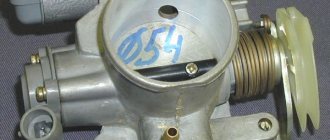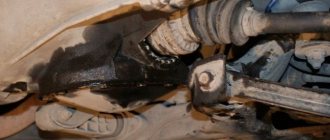Quite often, when operating an injection or carburetor car, you may encounter that the engine jerks during acceleration. In other words, after sharply pressing the gas pedal, there is no clear response from the power unit, a pause-failure occurs, the speed increases in jerks, etc.
These jerks are a rapid change in the crankshaft speed, regardless of the position of the gas pedal and the degree of pressure on the accelerator. As a rule, such jerks follow in series, causing the engine to jerk.
As for failure, that is, when the engine “stubs” during acceleration, there is a noticeable delay in the reactions of the internal combustion engine after the driver sharply presses the gas to increase the speed. Moreover, in both cases, when you smoothly press the gas pedal, the speed increases without jerks or delays, that is, quite predictably.
It is quite obvious that operating a vehicle with such faults is not only difficult, but also dangerous. While driving, there is no opportunity to overtake, quickly change lanes, etc. To solve the problem, the engine requires in-depth diagnostics, since it is first necessary to clearly determine the cause of the breakdown.
Next, we will talk about why an injection engine or carburetor engine jerks during acceleration, as well as what methods can be used to identify and fix problems that have arisen.
Self-check of the car, identification of symptoms
To understand the possible cause of the breakdown, you should clearly identify the symptoms, and based on this, draw some conclusions.
When the car is warmed up to operating temperature, when you press the gas pedal, it begins to “stupid” or twitch slightly, and then when you pick up speed, this problem disappears and the car operates normally.
If this problem occurs only during acceleration, and not, for example, when starting from a standstill, then the reasons will be the same. If the car jerks when starting from a standstill, then this may be a problem with the clutch or basket. If vibration is felt while driving and not only during acceleration, this may indicate a failure of the cushions securing the engine.
Additionally, we recommend reading our expert’s article, which talks about what vibration when braking means.
You can learn how to replace a timing belt with your own hands from our specialist’s detailed material.
Conclusion
If the car jerks during acceleration or when driving at low speeds, the reasons may be defects in the fuel system, engine, gearbox, ignition or other components. To understand which systems require repair, you need to pay attention to the nature of the twitching, intensity and accompanying symptoms. To accurately determine the problem, it is advisable to carry out diagnostics in a workshop, especially if the owner does not have experience in repairing the car with his own hands or does not have the necessary tools.
Diagnostics at the service center
Diagnostics can also be done at a service center. Especially if the car is fuel-injected, a special device is needed. It is connected to the control unit and shows where and on which sensor the problem is possible. The same goes for diesel cars. To check diesel engine injectors, you need a special stand. Without it, it is impossible to determine what condition they are in.
The mass air flow sensor (MAF) is faulty
If the MAF sensor sends incorrect information to the ECU, the air/fuel mixture may not be ok. It will either be too rich or too lean, causing the car to stall, jerk, shake and generally irritate the driver. The mass air flow sensor can be cleaned, but it usually requires replacement if such failures occur.
Causes of jerking during acceleration
There can be several reasons why a car jerks during acceleration.
Malfunctions in the engine ignition system
If the ignition fails, it will be strongly felt during acceleration. This happens because when you press the gas pedal, fuel is injected into the cylinders, and detonation should occur there. If the ignition is set incorrectly or fails, then fuel flows, but the spark strikes at the wrong time. In other words, some part of the fuel does not ignite or ignites at the wrong time. Some cylinders may not detonate at all. This all leads to unbalanced work and, consequently, jerks. The cause could also be faulty spark plugs or armor wires. It is advisable to change spark plugs sometimes. Spark plugs are checked using special equipment, where, at a pressure the same as in the engine, it is checked whether the spark plug produces a spark.
Even when the spark plugs appear to be in good working order and have no defects, this does not mean that they perform excellently. It is recommended to buy candles from a manufacturer that is not the cheapest, since even new ones may not pass the bench test.
Armor wires are checked with an ohmmeter for the presence of the required resistance. You can also check the quality of the connections between the wires and the spark plugs. The procedure should be carried out with a warm engine. You should take water into a bottle and use a sprayer to distribute it with the engine running on the armored wires and the connection with the spark plugs. If the engine speed begins to decrease and the car starts to stall, then the wires should be replaced.
If you do not understand how the ignition is set, it is better to contact a specialist. This process is quite accurate, there are no mistakes to be made there.
Malfunctions in the power system
The most common reason for a car jerking during acceleration is a problem with the power and fuel supply system. When you press the gas pedal due to contaminated elements of the fuel system, there is not enough fuel to accelerate. This is why jerks occur during acceleration.
The problem may be:
- Filters. The air filter and fuel filter need to be changed regularly. This is a consumable item that quickly breaks down.
- Contamination of the fuel supply system. In carburetor cars, these are jets in which the slightest dust or pieces of dirt greatly affect the flow of fuel. Injector nozzles may become clogged.
- Fuel pump. If it fails or partially begins to show less performance, namely, does not have time to pump the required fuel pressure into the system, then during acceleration this deficit will be visible.
There are various aerosols and additives for cleaning fuel systems. If you choose a product from a trusted manufacturer, they work very well. But this may not be enough in all cases. There are cases where mechanical cleaning or repair of individual parts is required. A valve or some other part of the mechanism may fail.
Bad spark plugs and/or coils
Sharp jerks during acceleration can occur when something is wrong with the fuel ignition. A faulty spark plug or failed ignition coil will cause misfire in one of the cylinders. This may cause slight jerking, especially when you are trying to accelerate.
In addition, unstable idling will be additional confirmation of problems with the spark plug or coil.
Resolving identified problems
Once the cause has been identified, you can begin to eliminate it. In most cases, this work should be entrusted to specialists. After all, the reasons that at first glance were key are not always exactly what they are. Correct ignition tuning, carburetor adjustment, injector adjustment is something that is best entrusted to a knowledgeable person. If it was determined that the jerking was caused by dirty filters, then you can use an aerosol cleaner. It is sprayed into the air filter hole. Fuel tank additives also perform quite well. These additives clean the fuel line pipes and all other elements. XADO additives have proven themselves well.
Dirty throttle
Jerking when accelerating can also occur if the throttle valve is dirty. The car will lack power and may stall after you press the gas pedal once and then let it idle. You can use special products from auto stores to clean the throttle body, but be careful. Excessive throttle body cleaning in older vehicles can result in high engine idle speed due to wear on the throttle body. Sometimes minor repairs to this unit may be required.
We eliminate jerks when the car starts moving
According to the number of reviews from owners of a Chevrolet Niva with a carburetor engine, it is the engine power system that most often poses a problem. Due to the breakdown of absolutely any element of the system, the stable process of fuel combustion in the cylinders can be disrupted. If an insufficient amount of mixture enters the cylinders, then the car in such conditions will not be able to produce the required power. Against the background of this problem, twitching will begin to appear.
Check the pipes, determine if there is any depressurization of the system. Measure the fuel pressure. If the indicator does not correspond to the norm, then further search for the cause should be sought in the pressure regulator, fuel pump. These actions must be performed not only with the carburetor system, but also with the injection system. If an injector is installed on the Niva 21214, then in this version the ignition system is also connected. The cause of the car jerking can be absolutely any sensor that has failed. Perhaps in this case you will need the help of specialists, because all the work is complicated by the presence of an electronic unit.
The appearance of jerking in the car when you sharply press the gas
If the cause is not related to the fuel pump, then these symptoms may indicate the so-called “triple” of the engine. A situation arises in a car in which out of 4 cylinders only one can work correctly. As a result of the “triple”, the engine simply cannot respond in time to pressing the gas pedal, after which similar problems arise. You can deal with the breakdown in the following ways:
- If the oxygen supply sensor is not working properly, the system is diagnosed using a multimeter. If any faults are found, it is simply replaced.
- If the valve timing in the engine is shifted, it is necessary, with the help of car service specialists, to adjust them according to the appropriate instructions.
- Detection of an incorrect glow number of spark plugs is resolved by installing a new set with the correct number.
- The problem of clogged injectors can only be solved at a car service center. To do this, they are installed on a special stand, which simulates the operation of a motor, and washed with a special solvent.
- The problem can also arise if the emulsion tube and well located in the design of the second chamber of the carburetor engine are clogged. The only solution here is to flush the carburetor and pipe with kerosene.
The car is shaking, what should I do?
At the first stage, the machine is diagnosed. Let's say that you have a Niva with a carburetor engine in your garage. Your car already shows signs of “illness” at the first stage of movement. Or the car started moving without any hassle, but when a certain number of revolutions was reached, the engine malfunctioned. All this will not give answers, but only creates questions, because anything can break. In any case, if unstable operation of the car’s power unit is noticed while pressing the accelerator pedal, the first thing you should do is:
- Check air and fuel filters. The supply of air and fuel to form a combustible mixture will be difficult if these elements are heavily contaminated.
- Check the fuel pump. Its incorrect operation leads to unstable fuel supply.
- Check fuel pressure. The supply of the fuel-air mixture under insufficient pressure often leads to jerking of the car. The pressure when the engine is running should not exceed 3 kgf/cm2.
Most of the reasons lie in the car's fuel system.
Poor quality fuel
Poor fuel quality is often the cause of acceleration failures. One of the possible situations that can deteriorate the quality of fuel is the ingress of water into it. If there is water in the fuel, the engine will definitely not work normally. For information: if water gets into aviation fuel, the aircraft engine instantly fails.
Substandard fuel in this area is one of the main causes of accidents in aviation. On earth, this problem costs the car owner less blood. If a car owner has filled the tank with fuel and water, then this fuel must be drained. Otherwise, you will have to change the fuel pump and injectors. If there is no way to drain the fuel, you will have to wait until the fuel is used up.
The car jerks while driving - reasons
As a rule, such jerks occur due to a malfunction of the ignition system. However, if a problem occurs on the road, you can try to fix the problem yourself. To do this we do the following:
- Turn off the ignition, lift the hood and make sure that all high-voltage wires are securely attached to the coil and spark plugs.
- Then start the engine and listen to the engine, listen for any extraneous crackling or clicking noises. The point is to check whether there are any “breakdowns to ground”, that is, whether the spark is going somewhere else other than the spark plug. This is best checked in the dark, then you will not only hear a crash, but also see how it hits, for example, on the body or somewhere else.
If the check does not lead to anything, I recommend unscrewing the spark plugs and inspecting them; perhaps there is carbon on the spark plugs or they simply need to be replaced. If you have a set of new spark plugs, check to see if the engine's performance changes or if the jerking goes away after replacing the spark plugs. If the car jerks at speed even after replacing the spark plugs have disappeared, then the problem was in them, but if not, continue searching or try to reach the nearest service center, they will certainly help you solve your problem.
The most common problem that car owners may encounter is sudden “jerking” of the car in different situations. For example, when accelerating, at low speed or at the very beginning of the movement. Those who have been driving for decades do not focus on this at all. This is explained by the fact that these “symptoms” can be expressed in any car, and it doesn’t matter how old it is, what brand it is, or how much experience its driver has.
The Lada Ten, the Hyundai Solaris, and any other car can “rush” off the ground. But this, in any case, is a deviation from the normal operation of the engine. Therefore, at the first unpleasant situations, it is necessary to identify the cause and get rid of the problem. Because the longer you ignore movements of this kind, the more the entire repair will cost you.
A jerking car is not the most desirable road user. If something happens, you will definitely add a couple of accidents to your collection. Photo: desertoasisautorepair.com
By the way, you should not try to solve the problem on your own if you are not confident in your skills and abilities. Entrust your car to a knowledgeable and experienced mechanic at a service station . Do this as soon as possible.
Problems with powertrain control calibrations
Very often, a breakdown of any sensor, ignition module, is displayed by a message on the instrument panel. However, there are exceptions when all mechanisms operate normally. There seem to be no malfunctions, but the engine still jerks when reaching speed. In this case, incorrect ECU calibration is to blame.
By the way, such symptoms do not always appear. Most often this happens when the engine is not warmed up enough. I had to observe when a cold engine experienced failures during acceleration. The reason for this behavior was the insufficient supply of fuel to the cylinders.
The way out of the situation is to update the software, which will not contain errors and will work without failures. As for the rest of those involved in acceleration jerks, not counting the injectors that have worn out over time and the faulty module, everything is fixable and does not pose a serious threat. It is important to promptly identify such a problem and eliminate it.
If we talk about turbocharged engines, jerks when the car moves are caused by the turbine itself. The weak point of the part is the pressure adjustment system, namely the electric drive, the electromagnetic valve element. The problem disappears after replacing the valve. Another question is when you have to completely change the turbine.
Why does a car start to jerk while driving?
Jerking or jerking while driving may indicate a problem with the engine, gearbox, transmission, or their mountings. Therefore, before checking components and assemblies, it is important to identify the characteristic factors that cause twitching.
Reason: engine malfunction
The car jerks when driving due to misfires that occur in one or several cylinders at once. Probable reasons:
- problem with the air-fuel mixture;
- malfunction of the ignition system, manifested by untimely supply of sparks to the cylinders or insufficient spark discharge strength;
- incorrect operation of the sensors.
Most of the causes of twitching will begin to manifest themselves in transient modes (during sudden acceleration or releasing the gas). On vehicles with a smart self-diagnosis system, the Check Engine light will definitely come on. By connecting the diagnostic scanner and reading the errors, you will most likely see the following fault codes:
- P0300 - multiple misfires;
- Р030Х, where X is the serial number of the cylinder in which misfires were registered;
- P0171 – lean mixture and/or P0172 – rich mixture.
Misfire fault codes are recorded by the engine ECU using the crankshaft position sensor (CPS), which detects a non-firing cylinder based on uneven rotation of the crankshaft. Errors in the mixture occur due to the entry of unburned oxygen and gasoline into the exhaust system, which is recorded by the exhaust gas toxicity control system using a lambda probe.
Ignition system diagnostics
- Checking spark plugs, which includes assessing the ceramic insulation for spark breakdown, monitoring the gap between the electrodes and the degree of erosion of the side electrode.
- Ignition coil diagnostics. The coils are checked using a spark gap with an adjustable gap between the electrodes. For example, a working individual coil should penetrate an air gap of 1.8-2 cm. If the coil is unable to cope with such a stress test, it means that it will also have problems providing a high-quality spark in the combustion chamber. During the diagnostic process, it would be useful to spray the coil body with water, and then run a tester connected to the battery ground around its perimeter. This way you will identify where the spark flows to ground.
- Checking high-voltage ignition wires. Start by visually inspecting the tips for cracks. Check resistance. But the most reliable testing method completely repeats the method of diagnosing the ignition coil housing for spark flow to ground. It is most convenient to notice a escaping spark in the absence of lighting.
If there is any suspicion of an insulation breakdown in a high-voltage circuit, the high-voltage wires and coil on a running engine should be touched with rubberized gloves. Otherwise, there is a risk of receiving a painful blow with a force of 24,000-40,000 V.
On vehicles with a contact ignition system, in case of jerks while driving, you should check the ignition timing, the quality of the contacts in the low voltage circuit, the condition of the slider, the breaker contacts and the gap between them, the serviceability of the vacuum corrector of the ignition distributor.
Identifying problems with the mixture
- Check the fuel rail pressure.
In the case of low pressure in the ramp, the car jerks when driving under load and when trying to accelerate sharply. You can check the pressure through a special fitting or adapter, which allows you to connect across the fuel line. To measure pressure, you can purchase a special kit or make a device yourself. You only need a pressure gauge with a measurement scale of up to 7 kg/cm2, a hose, a tee, a female and male quick-release type. - Check air leaks.
The suction of unaccounted air manifests itself at idle, when the throttle valve is open less than 25-30%, as well as during a sudden release of gas. Under such conditions, the vacuum in the intake manifold of a naturally aspirated engine is greatest. The vacuum system is checked using a smoke generator.In addition to twitching during transient conditions, you may notice floating speed, shaking and unstable operation of the engine at low loads.
On cars with a carburetor power system, jerks during acceleration are most often associated with a malfunction of the accelerator pump or clogged filter elements.
If the malfunction occurs when cold, check the circulation of coolant through the intake manifold, adjusting the quality and quantity.
Malfunctions of sensor equipment
It is likely that the twitching is caused by a broken sensor. If the ECU is able to detect an anomaly in the readings, the corresponding fault code will be stored in non-volatile memory. The most likely causes of jerking:
- wear of the resistive layer of the throttle position sensors and accelerator pedal. Due to signal loss and contact bounce, the engine ECU is unable to assess the actual load. Most often the car jerks when driving at low gas. During measured driving on the highway and in the city, most of the time the engine is in low and medium load mode, which corresponds to 10-45% throttle opening. Accordingly, the sliding contact of resistive sensors most often moves in this zone, erasing the conductive layer. Therefore, at full throttle, the car can accelerate smoothly, but at the same time jerk in low and partial load mode. You can check the sensors using a diagnostic scanner, observing its readings in real time;
- contamination of the air flow sensor. There is a characteristic jerk when accelerating from first gear. Due to contamination, the sensitivity of the sensor decreases, and at the same time the ability to adequately calculate the amount of air entering the cylinders. On diesel internal combustion engines, the malfunction is accompanied by thick black smoke during gas changes. You can diagnose the health of the sensor by measuring the voltage at its terminals with the ignition on. Using a diagnostic scanner, you can monitor the sensor readings in real time, comparing the actual amount of air with the reference values at different engine operating modes.
Video: Car Jerks When Moving for Several Reasons
If you notice that the car jerks when changing gears, the reason should be sought in the mechanical or electronic part of the automatic transmission. Typical malfunctions of torque converter automatic machines:
- insufficient ATF fluid level;
- wear of solenoids and their seats in the valve body;
- contamination of solenoids, spool valves, valve body channels;
- wear of the brake band (certain types of automatic transmissions).
On cars with a robotic gearbox, jerks when driving can be associated with overheating of the clutch, when the ECU begins to close the driven and driven discs faster to reduce their heating. Twitching most often occurs after a jam in a traffic jam and can completely disappear when the clutch returns to operating temperature. Faults that cause twitching:
- Worn clutch basket driven disc.
- Brush wear, contamination, break in the actuator motor circuit.
- Wear of levers and actuator gears (the first jerks appear when starting from a standstill).
The DSG robotic gearbox with dry clutch deserves special attention. Wear of the double-disc clutch is one of the most common causes of jerking when shifting.
The second weak point is Mechatronic (electro-hydraulic transmission control unit). Due to increased temperature loads, sensors and valves often fail, and the quality of contacts is impaired.
Rapid aging of the ATF fluid leads to clogging of the channels inside the mechatronics and wear of the solenoids.
To extend the service life of robotic gearboxes, the manufacturer recommends moving the gearbox to neutral when stopping for more than 5 seconds.
Jerking when driving a car with a CVT indicates damage to the cones, a stretched belt, or insufficient oil. For each type of automatic transmission, the adaptation parameter is extremely important. On many transmission models, the software needs to be re-learned even after a scheduled transmission fluid change.
Dying fuel pump
Another part that can cause your car to jerk when accelerating is the fuel pump. If it is about to die, it may not be providing the optimal level of pressure to the fuel injection system. This will result in insufficient fuel delivery and jerking.
